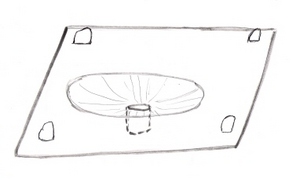You can survive without food for a long time. Without water, you can measure your future in mere days. And not many at that.
A water still can be helpful in situations where a water source cannot be found. You do need one thing to make this work, and that is a piece of clear plastic. Beyond that, you can improvise.
BELOWGROUND STILL
For a belowground still, dig a hole in a location where you believe the soil contains moisture. This could be a dry stream bed or could be on a beach above the waterline.
In a spot fully-exposed to the sun, dig a bowl-shaped hole about three feet across and two feet deep. At the bottom of the bowl-shaped excavation, dig a hole big enough for you to place a container in which to collect water. Insert the container.
If you can get it, a straw, hollow reed, or tube can act as a drinking straw so you won’t have to disturb the still any more than necssary while it is cooking. Run this down into the container with the free end out of the hole so that it is accessible.
Place clear plastic sheeting over the hole and anchor it by putting dirt, sand, or gravel around the edges. Don’t make it too tight because you aren’t done. In any event, don’t let the sheeting touch anything inside the hole or the moisture that gathers on the plastic will be leached off. That means plugging your straw as well to keep air from getting into your still.
Place a rock on top of the plastic sheeting in the center so the center dips down towards the container which itself should be centered beneath it.
Now thanks to the sun, the moisture in the soil in the hole will condense onto the underside of the plastic and, as it accumulates, bead up and slide towards the lowest point beneath the rock where it will drip into the container. With the tubing, you can drink whatever accumulates without disturbing the still. Keep the tube plugged until needed.
On the Kalahari episode of Discovery Channnel’s Survivorman, survival expert Les Stroud demonstrated how he could produce moisture that could condense in a totally dry environment by urinating in the prepared hole around where he would place his container.
It follows that this technique could be used around questionable water sources, given plenty of sunshine to do the condensation work and enough clear plastic sheeting to make additional stills to help produce what you need.
ABOVEGROUND STILL
For this, you need a slope, again exposed to the full sun.
Open your clear plastic bag so plenty of air is inside it.
Then fill the plastic bag full of green leafy vegetation only. This will not work with any posisonous vegetation. Make certain there are no sharp points to break the bag.
Place a small rock or other weight into the bag.
Close the bag and tie it closed securely.
If you have a straw, a hollow reed, or some tubing, put one end into the mouth of the bag as you tie it off. Plug the straw, reed, or tubing.
Now, place the bag down on the slope with the mouth on the downhill side. The mouth of the bag should be a bit higher than the lowest point of the bag which would be near the mouth,
Work the rock or weight in the bag to its low point. This is where the water will gather as it condenses inside the bag, accessible with straw, reed, or tubing. Or, lacking one of those, loosen the mouth of the bag, allow the water gathered around the rock or weight to drain out into a drinking container, retie the mouth and let the still continue to collect water for you.
The more plastic you have, the more stills you can prepare.





